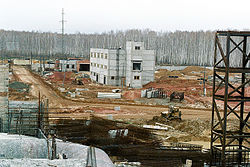In situ leaching is a mining technique for extracting minerals such as copper and uranium. Holes are drilled into the ore deposit and leaching fluid is pumped into the holes. The solution carrying the dissolved ore is then pumped back to the surface and processed. In uranium in situ mining, an acidic solution such as sulfuric acid or an alkaline solution such as sodium bicarbonate is used. In situ mining does little to disturb the landscape and there are no mine tailings or waste rock created.
The ore body must be permeable to the leaching solution. In addition, care must be taken that the leaching solution will not reach the ground water in the area of the mine. The choice of acidic or alkaline leaching solution depends on the geology of the ore body. In general, leaching with an acidic solution recovers more uranium and costs less than alkaline leaching.
The in-situ process is used around the world to extract forty five percent of the uranium mined. In situ mining of uranium started in the U.S. and Soviet Union in the early 1960s using sulfuric acid. Since 1970, all commercial in-situ uranium mines in the U.S. have used carbonate solutions which are alkaline.
Peninsula Energy Ltd has just finished the regulatory application process for the use of low pH in situ uranium mining at the Lance uranium project in Wyoming. Peninsula is now the only operator licensed to use low pH uranium extraction in the U.S. Low pH means that the leaching solution is acidic.
The Wyoming Department of Environmental Quality (WDEQ) formally approved an amendment to the Lance source materials license on 31 July. The WDEQ notified the Peninsula Energy Ltd subsidiary Strata Energy Inc the following day. The authorization confirmed that the acidic in situ leaching technology to be employed by Peninsula complies with the regulatory standards and requirements of the state regulator.
Wayne Heli is the CEO of Peninsula. He described the low pH recovery technique as a “proven and effective” method. Low pH recovery is in wide use in other parts of the world. Peninsula began working on authorization for their low pH in situ mining method in 2017. Tests had shown that using acidic rather than alkaline leaching solutions could possibly improve performance and reduce costs in uranium mining. Heli said, “The final implementation of this initiative is anticipated to bring significant benefit for our shareholders.”
Peninsula reduced uranium production at the Lance mine in the second quarter of 2019 to prepare for a transition from alkaline to acidic leaching. According to the amended Permit to Mine from the state regulatory authority, Peninsula must demonstrate the process before they can begin commercial operations. Peninsula said that actual commercial use of the acidic in situ mining at the Lance mine would be determined by “the timing and extent of improvement in the uranium market conditions and the companies’ requirements for produced uranium.” Currently, there are four in-situ mining operations in the U.S. including the Peninsula mine in Wyoming.
Blog
-

Peninsula Energy Has Been Authorized By Wyoming To Use Acidic Solutions For In Situ Mining Of Uranium At The Lance Mine
-

Geiger Readings for Aug 04, 2019
Ambient office = 83 nanosieverts per hour
Ambient outside = 99 nanosieverts per hour
Soil exposed to rain water =95 nanosieverts per hour
English cucumber from Central Market = 89 nanosieverts per hour
Tap water = 96 nanosieverts per hour
Filtered water = 81 nanosieverts per hour
-

Geiger Readings for Aug 03, 2019
Ambient office = 89 nanosieverts per hour
Ambient outside = 103 nanosieverts per hour
Soil exposed to rain water =104 nanosieverts per hour
Avocado from Central Market = 157 nanosieverts per hour
Tap water = 95 nanosieverts per hour
Filtered water = 75 nanosieverts per hour
Dover sole – Caught in USA = 104 nanosieverts per hour
-

Nuclear Weapons 691 – Plowshares Fund And Their Allies Fight Against Deployment Of New Low-yield Nuclear Warhead
I have blogged about new nuclear weapons that the U.S. wants to add to our nuclear arsenal. There has been a serious debate in Congress over whether or not we need some new weapons systems and how much money should be allocated for them.
The Trump administration has been pushing for the development and deployment of a “low-yield” tactical nuclear warhead that was proposed as part of the February 2018 Nuclear Posture Review. The Secretary of Defense and the Pentagon fully supported the addition of this new weapon to the U.S. nuclear arsenal. The GOP controlled Congress approved the new warhead. It was “fast tracked” for deployment in 2020.
Control of the U.S. House of Representatives passed to the Democrats in the 2018 elections. On July 12 of this year, the House voted to halt deployment of the new warhead. This marks the first time that the House voted to halt work on a new nuclear weapon in more than a decade. Democratic Representative Adam Smith from Washington State attended a Ploughshares policy conference in November. He said, “It makes no sense for us to build low-yield nuclear weapons. It brings us no advantage and it is dangerously escalating. It just begins a new nuclear arms race with people just building nuclear weapons all across the board in a way that I think places us at greater danger.”
The Plowshares Fund is a public grantmaking foundation that supports initiatives to prevent the spread and use of nuclear weapons, and to prevent conflicts that could lead to their use. They were working with allies against the deployment of the new warhead even before the 2018 elections.
The Ploughshares Fund and the Union of Concerned Scientists collaborated in drafting a letter to Congress to express their opposition to the new warhead. The letter was delivered to all members of Congress. Over thirty experts signed the letter including Bill Perry, former Secretary of State George P. Shultz, former Gov. Jerry Brown, former chairman of Strategic Command Gen. James Cartwright, former Sen. Richard Lugar, and Ben Rhodes, President Obama’s Deputy National Security Advisor and Ploughshares Board Member.
The Ploughshares Fund teamed with Democratic Representatives Ted Lieu of California and Ed Markey of Massachusetts to support a stand-alone bill to prohibit the new warhead. The bill was introduced in September of 2018. It was called the Hold the LYNE (Low-Yield Nuclear Explosive) Act. This bill became an effective focus point for opposition to the new warhead.
The Ploughshares Fund followed up their earlier letter and the new bill with face-to-face meetings with key Members of Congress. As the date of the vote taken this July approached, the Ploughshare Fund gathered the best advocates of their community to focus efforts. Organizations that cooperated included the Union of Concerned Scientists, Council for a Livable World, Global Zero, Beyond the Bomb, Women’s Action for New Directions, Friends Committee on National Legislation, Arms Control Association, and others.
As a result of the strenuous efforts by the Plowshares Fund and their allies, votes were won against the new warhead in the House Appropriations Committee, the HASC strategic forces subcommittee, and finally on the House floor. However, the fight over the new warhead is not done. The Senate Defense bill contains full funding for the new warhead. The next step is a conference between the House and Senate to develop a bill that both can agree on. If the new warhead can be removed from the final Defense bill approved by both houses, there is still a chance that the bill could be vetoed by President Trump but it is unlikely. Stay tuned. -

Geiger Readings for Aug 02, 2019
Ambient office = 93 nanosieverts per hour
Ambient outside = 107 nanosieverts per hour
Soil exposed to rain water =110 nanosieverts per hour
Cauliflower from Central Market = 105 nanosieverts per hour
Tap water = 105 nanosieverts per hour
Filtered water = 87 nanosieverts per hour
-

Russian Mayak Nuclear Site Probable Site Of Release Of Ru-106 In Fall Of 2017 – Part 2 of 2 Parts
Part 2 of 2 Parts (Please read Part 1 first)
In November of 2017, Rosatom, the Russian state-owned nuclear corporation issued a statement that read, “The recent release of ruthenium-106 that has been detected across Europe did not come from a Rosatom facility. All Rosatom nuclear facilities, including nuclear power plants and nuclear fuel reprocessing sites, are operating safely and normally. There were no incidents at any of these sites during the period of September-October 2017.”
Rosatom issued another statement on the Ru-106 release today. The statement read, “We maintain that there have been no reportable events at any Rosatom-operated plants or facilities. Both the national regulator and experts from an independent international inquiry inspected the Mayak facility back in 2017 and found nothing to suggest that the ruthenium-106 isotope originated from this site, nor found any traces of an alleged accident, nor found any evidence of local staff exposure to elevated levels of radioactivity.”
“The recent PNAS report does not contain any new data or facts that differ from the data previously used by the national regulator and the independent international inquiry which reviewed all the scenarios, including that of an alleged accidental leak on the Mayak facility.
“The independent international inquiry has found the accidental release scenario to be inconsistent with the established facts.
“Had an accidental release of the alleged magnitude (250 TBq at once, as suggested in the PNAS report) taken place, the facility’s automated control and monitoring systems would have recorded radioactivity thousands of times higher than what was actually recorded. Such levels would have triggered alarms at the plant to evacuate staff and residents from the surrounding area. If staff had been exposed to this much radiation, the ruthenium-106 would have been detectable. However, 250 of the Mayak site employees, including those working in its radiochemistry plant, were checked by an independent lab and none of them were found to have any traces of excess exposure.”
“Contrary to a speculative theory in the PNAS report, the cerium-144 project activities conducted at the Mayak facility from August to November 2017 were related only to rare-earth concentrate which would only contain barely detectable traces of ruthenium-106 isotope.”
It took ten years for Russia to admit that the Chernobyl accident had occurred in 1986. On numerous other occasions, Russia has either refused to admit that nuclear accidents had occurred, or they downplayed the significance of an accident. Just recently, a fire on a Russian experimental submersible killed fourteen crewmen. It took days for Russians to admit that a fire had killed the crewmen. They were also very vague about exactly what the submersible was designed for and what happened.
Taking their secretive attitude about nuclear accidents into account, it is difficult to accept what the Russian have said about the Ru-106 release. Their Mayak nuclear site has experienced a number of serious releases of radiation and radioactive materials. It would be wise to believe the European scientists who conducted a detailed study over the Russian announcement of total innocence. Mayak is probably the source of the Ru-106 release.
